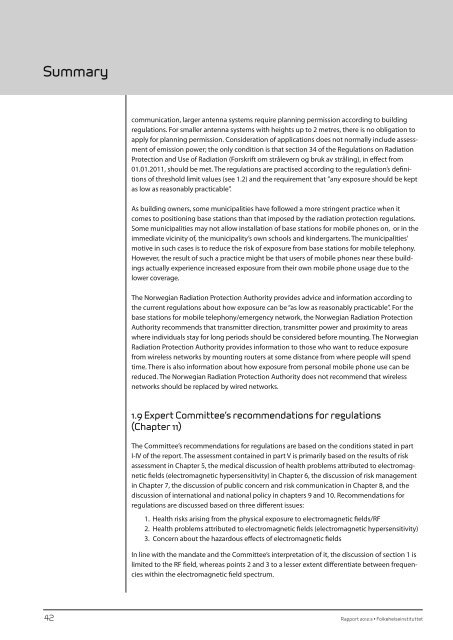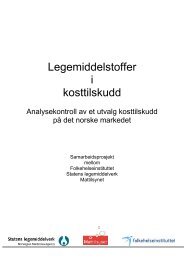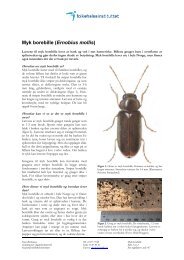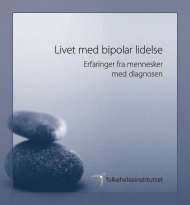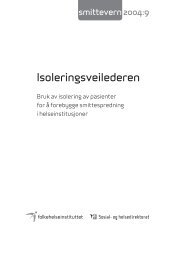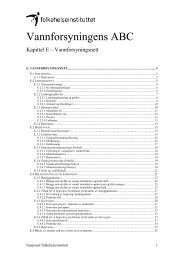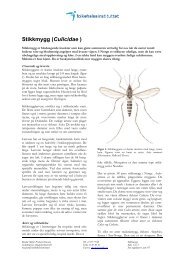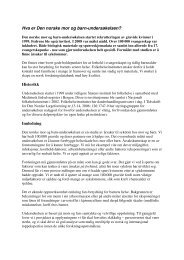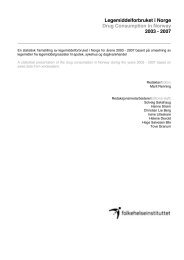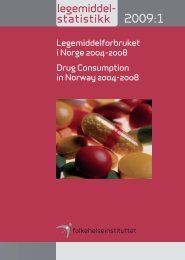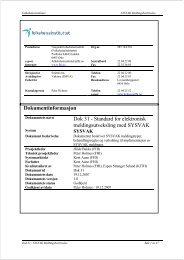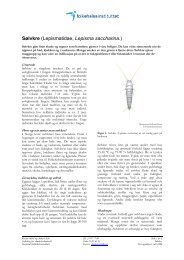rapport 2012:3 - Nasjonalt folkehelseinstitutt
rapport 2012:3 - Nasjonalt folkehelseinstitutt
rapport 2012:3 - Nasjonalt folkehelseinstitutt
Create successful ePaper yourself
Turn your PDF publications into a flip-book with our unique Google optimized e-Paper software.
Summary<br />
communication, larger antenna systems require planning permission according to building<br />
regulations. For smaller antenna systems with heights up to 2 metres, there is no obligation to<br />
apply for planning permission. Consideration of applications does not normally include assessment<br />
of emission power; the only condition is that section 34 of the Regulations on Radiation<br />
Protection and Use of Radiation (Forskrift om strålevern og bruk av stråling), in effect from<br />
01.01.2011, should be met. The regulations are practised according to the regulation’s definitions<br />
of threshold limit values (see 1.2) and the requirement that ”any exposure should be kept<br />
as low as reasonably practicable”.<br />
As building owners, some municipalities have followed a more stringent practice when it<br />
comes to positioning base stations than that imposed by the radiation protection regulations.<br />
Some municipalities may not allow installation of base stations for mobile phones on, or in the<br />
immediate vicinity of, the municipality’s own schools and kindergartens. The municipalities’<br />
motive in such cases is to reduce the risk of exposure from base stations for mobile telephony.<br />
However, the result of such a practice might be that users of mobile phones near these buildings<br />
actually experience increased exposure from their own mobile phone usage due to the<br />
lower coverage.<br />
The Norwegian Radiation Protection Authority provides advice and information according to<br />
the current regulations about how exposure can be “as low as reasonably practicable”. For the<br />
base stations for mobile telephony/emergency network, the Norwegian Radiation Protection<br />
Authority recommends that transmitter direction, transmitter power and proximity to areas<br />
where individuals stay for long periods should be considered before mounting. The Norwegian<br />
Radiation Protection Authority provides information to those who want to reduce exposure<br />
from wireless networks by mounting routers at some distance from where people will spend<br />
time. There is also information about how exposure from personal mobile phone use can be<br />
reduced. The Norwegian Radiation Protection Authority does not recommend that wireless<br />
networks should be replaced by wired networks.<br />
1.9 expert Committee’s recommendations for regulations<br />
(Chapter 11)<br />
The Committee’s recommendations for regulations are based on the conditions stated in part<br />
I-IV of the report. The assessment contained in part V is primarily based on the results of risk<br />
assessment in Chapter 5, the medical discussion of health problems attributed to electromagnetic<br />
fields (electromagnetic hypersensitivity) in Chapter 6, the discussion of risk management<br />
in Chapter 7, the discussion of public concern and risk communication in Chapter 8, and the<br />
discussion of international and national policy in chapters 9 and 10. Recommendations for<br />
regulations are discussed based on three different issues:<br />
1. Health risks arising from the physical exposure to electromagnetic fields/RF<br />
2. Health problems attributed to electromagnetic fields (electromagnetic hypersensitivity)<br />
3. Concern about the hazardous effects of electromagnetic fields<br />
In line with the mandate and the Committee’s interpretation of it, the discussion of section 1 is<br />
limited to the RF field, whereas points 2 and 3 to a lesser extent differentiate between frequencies<br />
within the electromagnetic field spectrum.<br />
42 Rapport <strong>2012</strong>:3 • Folkehelseinstituttet


